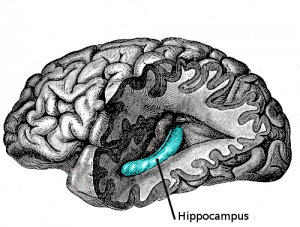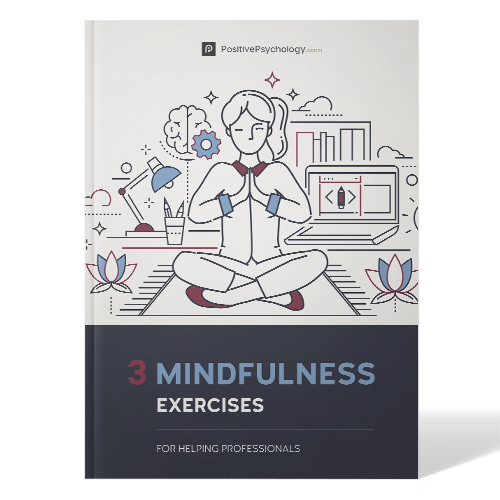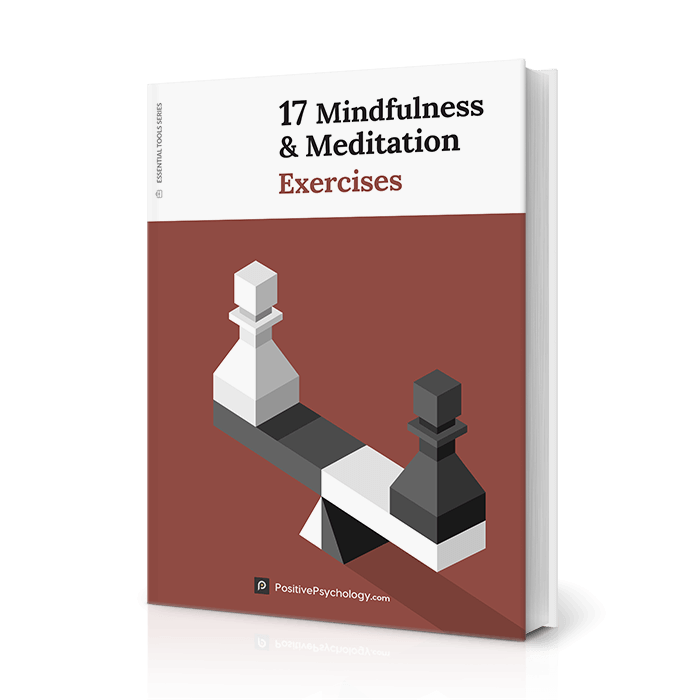23 Amazing Health Benefits of Mindfulness for Body and Brain
 If you’ve been following this blog, you know that there are countless ways to apply mindfulness in your everyday life.
If you’ve been following this blog, you know that there are countless ways to apply mindfulness in your everyday life.
You have probably also noticed that there are tons of benefits of practicing mindfulness regularly.
Although we’ve talked about these benefits in a few other places, we thought it would be helpful to provide one resource that breaks down all of the great benefits of practicing mindfulness in one place, with sources to back them up.
If you’re wondering what you can get out of being mindful, read on to learn about all the great things mindfulness can do for you!
Before you read on, we thought you might like to download our three Mindfulness Exercises for free. These science-based, comprehensive exercises will not only help you cultivate a sense of inner peace throughout your daily life but will also give you the tools to enhance the mindfulness of your clients, students or employees.
This Article Contains:
The 5 Most Common Benefits of Mindfulness
We’ll start with some of the benefits you probably already expect from mindfulness, like enhancing your ability to deal with everyday struggles.
1. Decreased stress
If you read our piece on Mindfulness-Based Stress Reduction (MBSR), you know that mindfulness is considered a key element to fighting stress.
An entire stress reduction program, with decades of experience and tens of thousands of practitioners, is an excellent indication that mindfulness works.
In addition to the outcomes of MBSR, there have been numerous studies supporting the idea that mindfulness reduces stress.
One study on present-moment awareness found that it facilitates an adaptive response to daily stressors (Donald, Atkins, Parker, Christie, & Ryan, 2016). Another study by Donald and Atkins (2016) found evidence that mindfulness produced less avoidance and more approach coping as a response to stress than relaxation or self-affirmation controls.
Mindfulness can also help alleviate stress by improving emotion regulation, leading to a better mood and better ability to handle stress (Remmers, Topolinski, & Koole, 2016).
The impact of mindfulness on stress can also be seen in several specific groups, including:
- Those who suffer from restless legs syndrome (Bablas, Yap, Cunnington, Swieca, & Greenwood, 2016);
- Parents (Gouveia, Carona, Canavarro, & Moreira, 2016);
- Healthcare professionals (Burton, Burgess, Dean, Koutsopoulou, & Hugh-Jones, 2017);
- Veterans with depression and/or PTSD (Felleman, Stewart, Simpson, & Heppner, 2016);
- Police officers (Bergman, Christopher, & Bowen, 2016).
For an excellent dive into how mindfulness affects the experience of stress, check out the Little Book of Mindfulness by Rebecca Howden and Medibank. I’ll leave it to them to dive into the nitty-gritty, but I’ll describe their explanation of the relaxation response.
Howden and Medibank first list the symptoms of stress, including:
- Constantly feeling anxious and worried;
- Feeling irritable, agitated and easily annoyed;
- Argumentative and defensive with friends and family;
- Restless sleeping;
- Low levels of energy, often waking up feeling tired;
- Restless and frenetic mind;
- Often self-critical and/or critical of others;
- Feeling flat and uninspired;
- Having difficulty concentrating;
- Skin rashes and conditions;
- Clenching your jaw muscles and grinding your teeth at night;
- Headaches and migraines.
When you induce a state of relaxation, which can be achieved through mindfulness, another kind of meditation, or other activities, you can reap the benefits, including:
- Higher brain functioning;
- Increased immune function;
- Lowered blood pressure;
- Lowered heart rate;
- Increased awareness;
- Increased attention and focus;
- Increased clarity in thinking and perception;
- Lowered anxiety levels;
- Experience of being calm and internally still;
- Experience of feeling connected.
Gaining these benefits can be as simple as closing your eyes and being silent for a few minutes a day. This is a practice that is so easy, anyone can do it!
2. Enhanced ability to deal with illness
Perhaps one of the most studied groups in terms of the impacts of mindfulness is cancer patients and others who are suffering from a chronic or potentially terminal illness.
Mindfulness may not take away their symptoms, but it can help make them more manageable.
For example, the eCALM trial, a therapy program for cancer patients, found that mindfulness can reduce symptoms of stress, enhance spirituality and non-reactivity to experience, facilitate post-traumatic growth, and enhance vigor while relieving fatigue (Zernicke, Campbell, Speca, ruff, Tamagawa, & Carlson, 2016).
Another cancer-specific mindfulness program decreased rumination and worry and increased observing and nonjudging in cancer patients (Labelle, Campbell, Faris, & Carlson, 2015).
An exploration of MBSR for those suffering from chronic low back pain found that mindfulness improved patients’ ability to function independently and resulted in less back pain than treatment as usual (Cherkin, Sherman, Balderson, Cook, Anderson, Hawkes, Hansen, & Turner, 2016).
Mindfulness can also help patients to focus less on the pain, improving their quality of life
(Garland & Howard, 2013).
A study on the use of MBSR with lung cancer patients and their partners showed that mindfulness can instigate a process of positive change in patients and their partners, as well as relieving caregiver burden in partners (van den Hurk, Schellekens, Molema, Speckens, & van der Drift, 2015).
Similarly, a review of MBSR for family caregivers found that mindfulness can decrease stress, depression, and anxiety in those caring for a loved one who is sick (Li, Yuan, & Zhang, 2016).
3. Facilitation of recovery
Mindfulness can not only help you deal with a chronic or potentially terminal illness or life-threatening event, but it can also help you move on from it.
A study of MBSR in Chinese breast cancer survivors provided evidence that mindfulness can enhance post-traumatic growth and decrease stress and anxiety in cancer patients (Zhang, Zhou, Feng, Fan, Zeng, & Wei, 2017).
Another study of young breast cancer survivors showed that women who practiced mindfulness were more likely to experience increased self-kindness, decreased rumination, and decreased stress (Boyle, Stanton, Ganz, Crespi, & Bower, 2017).
Mindfulness, yoga, and meditation have also been found to decrease anxiety and facilitate post-traumatic growth in breast cancer survivors, in addition to increasing vigor and spirituality (Tamagawa, Speca, Stephen, Lawlor-Savage, & Carlson, 2015).
4. Decreased depressive symptoms
Mindfulness has long been considered an effective supplemental treatment for depression.
It has been found to decrease depressive symptoms, anxiety, and stress in college students, as well as increasing self-compassion when compared with yoga alone (Falsafi, 2016).
One of the ways in which mindfulness can help treat depression is through enhancing practitioners’ ability to regulate their emotions. Mindfulness provides the tools needed to step back from intense negative emotions, identify them, and accept them instead of fighting them. This allows mindful thinkers to better regulate their emotions, leading to better coping and management of depression.
A study by Costa and Barnhofer (2016) backs this theory. They found that, when compared to guided imagery relaxation, a brief training in mindfulness helped participants struggling with depression to reduce their symptoms through greater emotion regulation.
Another study found that MBCT reduced depressive episodes, which not only helped participants feel better but also had positive impacts on their health care costs (Shawyer, Enticott, Özmen, Inder, & Meadows, 2016).
Mindfulness is even effective for people dealing with the most critical of depressive symptoms: suicidal ideation, or thoughts of suicide. In chronically depressed participants with suicidal thoughts, mindfulness was more effective than treatment as usual in reducing these thoughts (Forkmann, Brakemeier, Teismann, Schramm, & Michalak, 2016).
5. Improved general health
Beyond the many mental health benefits of mindfulness, it can also improve your general health.
For example, a study of how the two facets of mindfulness impact health behaviors found that practicing mindfulness can enhance or increase multiple behaviors related to health, like getting regular health check-ups, being physically active, using seat belts, and avoiding nicotine and alcohol (Jacobs, Wollny, Sim, & Horsch, 2016).
Another study on mindfulness and health showed that mindfulness is related to improved cardiovascular health through a lower incidence of smoking, more physical activity, and a healthier body mass index (Loucks, Britton, Howe, Eaton, & Buka, 2015).
Additionally, mindfulness has been positively linked with lower blood pressure, especially when the practitioner is skilled in nonjudging and nonreactivity (Tomfohr, Pung, Mills, & Edwards, 2015).
Finally, in a study on the impacts of mindfulness on the psychological and physical health of obese or overweight adults, researchers found that mindfulness helped participants lose weight, improve their eating behaviors and attitudes, and decrease depression and anxiety (Rogers, Ferrari, Mosely, Lang, & Brennan, 2017).
While all of these benefits of mindfulness can be experienced by children as well as adults, there are some benefits that have been found specifically in young people. These are outlined in the next section.
Health Benefits of Mindfulness for Kids and Students

Mindfulness studies with children as the participants are becoming more common as well, as more and more benefits of mindfulness on early development are discovered. We’ll describe some of the amazing outcomes associated with mindfulness on children, teens, and young adults here.
Benefits for college students
Adults are not the only ones who can reap the benefits of mindfulness.
College students have also experienced incredible positive impacts resulting from the practice of mindfulness.
A study on mindfulness in college students found that medical and psychology students who practiced mindfulness reported improvements in a wide range of areas, including decreased reactivity, increased curiosity and affect tolerance, improved patience, and self-acceptance, and enhanced relational qualities (Solhaug, Eriksen, de Vibe, Haavind, Friborg, Sørlie, & Rosenvinge, 2016).
Problems with alcohol are more prevalent in college students than many other populations and can lead to serious issues with both academic progress and life in general. Mindfulness may be an effective tool for addressing this issue, as it has been negatively linked with alcohol problems and can help students deal with the stress that may prompt drinking in this population (Bodenlos, Noonan, & Wells, 2013).
Mindfulness has also been shown to be an important link between the depressive symptoms that spring from alcohol-related problems and the incidence of drinking to cope in college students (Bravo, Pearson, Stevens, & Henson, 2016).
College students who practice or have practiced mindfulness were less likely to experience depression stemming from the use of alcohol to cope with their problems.
Another study on drinking in college students found that those who practice mindfulness are engaged in lower rates of problematic drinking, especially those proficient in acting with awareness and nonjudging (Vinci, Spears, Peltier, & Copeland, 2016).
The effects of mindfulness on the likelihood of drinking may be due in part to the impact of mindfulness on self-control. College students who participated in mindfulness-based stress reduction (MBSR) reported enhanced self-control and vitality, among other outcomes (Canby, Cameron, Calhoun, & Buchanan, 2015).
Similarly, a study on mindfulness and emotion regulation in college students found that higher levels of mindfulness predicted better regulation of emotions and suppression of thoughts (MacDonald & Baxter, 2016). Better self-regulation and self-control contribute to the more effective positive inhibition of destructive behaviors and, in turn, greater psychological wellbeing.
In general, children are not likely to have the same problems college students do (especially problems like over-imbibing!), but there are many areas in which mindfulness can have positive outcomes for children.
Improved academic success
Mindfulness is known to be effective in helping students achieve academic success in a variety of ways, and this benefit is not reserved for any specific group.
The following groups of children have enjoyed the benefits of mindfulness when it comes to their academic performance:
- Elementary students who practice mindfulness exhibit greater prosocial behaviors, emotion regulation, and academic performance (Harpin, Rossi, Kim, & Swanson, 2016);
- Teenagers studying for a general education certificate who participated in a mindfulness program experienced lower depression and anxiety, which contributed to improved academic attainment (Bennett & Dorjee, 2016);
- Children from lower socioeconomic backgrounds who participated in a five-week mindfulness program reported decreased stress, allowing them to focus on school (Costello & Lawler, 2014);
- Urban male youth who participated in MBSR experienced less stress, anxiety, and negative coping, improving their ability to deal with academic stress and achieve academic success (Sibinga, Perry-Parrish, Chung, Johnson, Smith, & Ellen, 2013);
- Children with ADHD displayed less aggression and conduct problems when exposed to mindfulness therapy, which helps them focus on their academics (Singh, Soamya, & Ramnath, 2016);
- Homeless middle school students who participated in a mindfulness course reported greater wellbeing and a higher incidence of using mindfulness in school, which can lead to greater quality of life and academic achievement (Viafora, Mathiesen, & Unsworth, 2015).
Buffer against bullying and depression
Mindfulness can even help kids deal with bullies!
A Chinese study on bullying victims and depression showed that mindfulness can protect children against the depressive symptoms that can arise from being victimized by bullies (Zhou, Liu, Niu, Sun, & Fan, 2017).
A dissertation by Sandra Mccloy (2005) on mindfulness as a coping tool for bullying suggested that mindfulness can help children consider perspectives other than their own and find constructive reactions in the face of bullying.
Mindfulness may even be an effective tool for addressing bullying at the source. Improving empathy with tools like mindfulness and improving social and emotional learning could be the key to stopping bullies before they become bullies (Kaldis & Abramiuk, 2016).
Provide support and boost resilience
Mindfulness can also aid children who have been involved in the welfare or mental health care system. A study on a mindfulness program for vulnerable children found that mindfulness improved emotion regulation, mood, empathy, confidence and self-esteem, coping and social skills, and ability to pay attention and focus (Coholic & Eys, 2016).
Resilience is a very effective skill for children to cope with daily struggles and develop emotionally, psychologically, and academically. Mindfulness training has been shown to boost resilience in children and help them understand and regulate their own emotions (Coholic, 2011; Coholic, Eys, & Lougheed, 2012).
In the classroom, mindfulness can be as simple as adding a station for students to visit any time they are feeling a hard emotion. This station can have crayons and be a “pause” station for students to spend 5-10 minutes before reflecting on the emotion.
Another study showed that mindfulness-based cognitive therapy for children reduced problem behaviors, attention problems, and anxiety while improving children’s social-emotional resiliency (Semple, Lee, Rosa, & Miller, 2010).
And the benefits of mindfulness don’t stop here. Mindfulness in the workplace also has numerous benefits for all levels of staff.
Advantages of Integrating Mindfulness in the Workplace

There are several ways that mindfulness has been shown to impact job performance, including:
- Gallant (2016) found that mindfulness can improve executive functioning by improving inhibition abilities;
- Mindfulness in service industry workers improves job performance, even when controlling for workers’ level of engagement (Dane & Brummel, 2014);
- De Bruin, Formsma, Frijstein, & Bögels (2017) showed that mindfulness in the workplace can actually increase the number of contract hours worked by employees, a result that will certainly catch the attention of higher-ups;
- Office employees who participated in an eight-week mindfulness intervention experienced lower levels of work-related stress, greater job satisfaction, and, ultimately, enhanced job performance as rated by their employers (Shonin, Van Gordon, Dunn, Singh, & Griffiths, 2014).
Beyond job performance, mindfulness has also been applied to the workplace for other benefits that can contribute to a healthy and productive work environment.
Reduced work-related stress and psychological distress
One of the most common benefits of practicing mindfulness in the workplace is the decrease in stress experienced by employees.
Researchers Grégoire and Lachance (2015) found that employees at call centers who took part in a brief mindfulness intervention reported decreased stress, anxiety, depression, fatigue, and negative affect, while also experiencing greater satisfaction at work.
Similarly, employees from the Dow Chemical Company enjoyed less stress and increased resiliency and vigor after completing an online mindfulness intervention (Aikens et al., 2014).
Huang, Li, Huang, and Tang (2015) also found that mindfulness reduces stress, fatigue, and psychological distress, especially for employees struggling with poor mental health.
A study of public sector employees showed that this group was also able to benefit from the mental health effects of mindfulness. These employees reported less stress, reduced psychological distress, and improved social functioning and quality of life (Bartlett et all, 2016).
Decreasing turnover and burnout
Along with the decreases in stress, mindfulness can also lower the incidence of burnout and turnover at work.
Researchers Taylor and Millear (2016) found that mindfulness helps employees construct a buffer between their work and becoming burned out.
Dane and Brummel’s (2014) study also discovered an inverse relationship between mindfulness and turnover intention, meaning that employees who are higher in mindfulness are less likely to leave their jobs for any reason. The study referenced earlier by de Bruin and colleagues (2017) also uncovered the reduction in the risk of employees dropping out of work when mindfulness is encouraged in the workplace.
Burnout seems to occur less in workplaces that encourage and offer spaces for mindfulness.
Goodman and Schorling (2012) found that mindfulness-based stress reduction reduced work-related burnout and improved mental wellbeing among healthcare providers. A study of Australian psychologists added more support to this theory, finding a strong negative association between mindfulness and burnout (Di Benedetto & Swadling, 2014).
Further research on mindfulness at work showed that mindfulness can act as a buffer for unsupportive work environments, enhancing wellbeing at work and contributing to lower levels of burnout for employees from a range of careers (Schultz, Ryan, Niemiec, Legate, & Williams, 2015).
Clearly, mindfulness has some extremely positive impacts on both individuals and the work they produce. But how does mindfulness produce these outcomes?
Research on Mindfulness and the Brain

It’s clear that practicing mindfulness can lead to positive outcomes, but many researchers want to know why it works as well.
This is where neuroplasticity comes in.
Explaining neuroplasticity
Neuroplasticity is, at its most basic level, the ability of the brain to change and adapt over time.
This adaptation happens regularly, as the brain constantly works to make itself more efficient and effective, but neuroplasticity is of specific interest to researchers in the context of brain injuries like a stroke. Our brains can actually reorganize themselves to ensure that functions continue unhindered after a traumatic injury (Honan, 2017).
Whenever we complete a new task or find a more effective way to do something, our brain takes note, often making structural or connection changes to facilitate our next attempt at this task.
When we practice mindfulness, we send the message to our brain that we are more effective at dealing with everyday tasks when we are aware, observant, nonreactive, and nonjudgmental. This causes our brain to make the changes that will improve our ability to function mindfully.
Note: For the more neurobiologically inclined among our readers, continue on in this section to read more about how the brain changes after practicing mindfulness. If you’ve already had enough talk of brain structures and gray matter, feel free to skip the jargon and head straight to the next section!
For example, meditation practice has been linked to an increased thickness in the cortex, an area that is important for a general cognitive function like attention and sensory processing (Lazar et al., 2005).
Similarly, long-term meditation is linked with a denser gray matter in the brain stem, an area that is linked to cardiorespiratory control (Vestergaard-Poulsen, van Beek, Skewes, Bjarkam, Stubberup, Bertelsen, & Reopstorff, 2009). This may help explain how mindfulness produces positive outcomes in cardiovascular, as well as general, health.
A study on an 8-week MBSR program showed that the regular practice of mindfulness increased grey matter in the left hippocampus, an area involved in learning and memory (Hölzel, Carmody, Vangel, Congleton, Yerramsetti, Gard, & Lazar, 2011). This finding can help us make sense of the improvements in academic achievement and job performance that can result from mindfulness.
Mindfulness has also been shown to result in changes in white matter, particularly in areas involving brain interconnection and self-regulation (Tang, Lu, Fan, Yang, & Posner, 2012). You’ll recall from above that improved self-regulation is a key result of mindfulness practice, and can lead to a plethora of advantageous outcomes.
In general, mindfulness is known to impact brain systems that control emotion regulation and self-awareness (Paulus, 2016), which makes sense given the outcomes we have seen in the practice of mindfulness.
Functional Magnetic Resonance Imaging

More specifically, one study used functional magnetic resonance imaging (fMRI) to assess changes in the brain after an eight-week mindfulness course.
Results showed that the prefrontal cortex, the hippocampus, and other areas experienced heightened activity and connectivity, while the amygdala experienced decreased functional activity and earlier deactivation after exposure to emotionally charged stimuli (Gotink, Meijboom, Vernooji, Smits, & Hunink, 2016).
This means that the areas of the brain associated with higher-level functioning were more active, while the area of the brain that handles stress and strong emotions was less involved. These findings match the behavioral changes we see after a mindfulness program, like better emotion regulation, less reactivity, and even better performance on tasks.
Another study of brain activity related to mindfulness found evidence that mindfulness is associated with areas of the brain related to memory retrieval, decision making, and outward attention, all functions which can help link the bridge between mindfulness and improved mental health and job performance, among other outcomes (Gartenschläger, Schreckenberger, Buccholz, Reiner, Beutel, Adler, & Michal, 2017).
While the science of neuroplasticity in relation to mindfulness is still relatively young (as neuroscience as a whole is relatively young!), these studies and others have provided a solid foundation for continuing research on how mindfulness impacts the brain.
Benefits of mindfulness – Psych2Go
The Importance of Consistent Practice
“Each morning we are born again. What we do today is what matters most.”
Buddha
While everyone has something to gain from practicing mindfulness, there is one caveat: to reap the maximum benefits of mindfulness, it truly needs to be a practice, meaning that it must occur regularly and often.
Nearly all of the articles mentioned above on the benefits of mindfulness are based on a mindfulness practice of five to eight weeks, or more. While a regular practice is vital, it does not need to be a huge commitment. Even a brief, 10-minute daily practice can result in more efficient cognition and better self-regulation (Moore, Gruber, Derose, & Malinowski, 2012)!
Another study on the effects of a 10-minute mindfulness exercise showed that even just a few minutes of mindfulness practice can lead to better executive attention and recognition memory, leading to better performance on a simple task (Watier & Dubois, 2016).
If you need some tips on how to commit to a regular mindfulness practice, try the following (Lucid Living, 2013):
- Find the right motivation and intention. If you are experiencing a busy day or just don’t feel like practicing mindfulness, it might help to remind yourself why you practice and what it can do for you.
- Find the right attitude and attention. Each practice will be different, but try not to think of them as “better” or “worse.” There is no bad way to become more mindful.
- Find the right time and timing. Just as each practice will be different, the length of time appropriate for your practice can vary as well. Some days you may need only a few minutes, and other times you may want to stick with it for a bit longer to make sure you have a rewarding experience.
- Find the right spot and posture. It’s important to feel safe and secure, wherever you decide to practice. That may be on a cushion on the floor, in your office chair at work, or even sitting in your car in traffic. You will benefit from finding a comfortable and familiar spot for your regular practice, but there’s no harm in modifying your seat or posture if circumstances require it!
- Find the right routine and stick to it! Although the length, location, and posture of your practice can and will change depending on your situation, it’s best to make a minimum commitment when it comes to frequency. Whether practicing once a day works best for you, or multiple times a day, find a routine that you will be able to stick to in the long-term.
Another helpful way to support your commitment to a daily practice of mindfulness is to assign a different value to each day’s practice.
Dr. Amit Sood, the chair of the Mayo Mind Body Initiative, provides the following mindfulness schedule as a template:
- Monday: Gratitude – Find things to be thankful for throughout your day, and include them in your loving kindness meditation or a gratitude journal;
- Tuesday: Compassion – Set an intention to decrease any pain or suffering in others that you encounter throughout your day;
- Wednesday: Acceptance – Accept yourself as you are and others as they are; appreciate yourself and other people without trying to change them;
- Thursday: Meaning and Purpose – Think about your ultimate purpose in life, and where and how you find meaning;
- Friday: Forgiveness – Forgive yourself first, then extend your forgiveness to others for any past transgressions;
- Saturday: Celebration – Make sure to take a day to celebrate all the joy in your life and the lives of others;
- Sunday: Reflection – Reflect on your week, your month, your year, or whatever period of time makes sense to you at the moment. This can be accomplished through meditation, prayer, or simple awareness.
A Take-Home Message
This article was packed with a lot of information, but I hope you found that it was worth your time.
To recap, this article included numerous potential benefits of practicing mindfulness for adults, children, and employees, including:
- Decreased stress and psychological distress in adults and employees;
- Enhanced mental health and functioning;
- Increased emotion regulation and self-control;
- Decreased anxiety, depression, worry, and rumination;
- Reduced incidence of problem drinking and symptoms associated with problem drinking;
- Enhanced academic achievement in students, due to improved ability to focus and improved attention;
- Improved social and relational skills;
- Reduction in aggression and problem behaviors in children;
- Reduced symptoms of burnout in employees;
- A decrease in turnover and turnover intentions at work;
- Enhanced job performance;
- Increased ability to cope with bullying;
- Enhanced resilience in children.
There are so many amazing benefits to practicing mindfulness, with more being discovered all the time. With such positive potential outcomes, the reasons not to practice mindfulness are quickly evaporating.
If you’ve decided to give mindfulness a try, restart a stalled practice, or if you’re looking to enrich your mindfulness practice or contribute to a healthy practice by your clients, check out our pieces on mindfulness-based stress reduction, mindfulness exercises and techniques for adults, and mindfulness exercises and techniques for children and teens.
I hope you find these tips and techniques as helpful as I did!
Thanks for reading, and please be sure to let us know in the comments section if you have experienced any of these benefits in your practice, or benefits not listed here.
We hope you enjoyed reading this article. Don’t forget to download our three Mindfulness Exercises for free.
- Aikens, K. A., Astin, J., Pelletier, K. R., Levanovich, K., Baase, C. M., Park, Y. Y., & Bodnar, C. M. (2014). Mindfulness goes to work: Impact of an online workplace intervention. Journal of Occupational and Environmental Medicine, 56, 721-731.
- Bablas, V., Yap, K., Cunnington, D., Swieca, J., & Greenwood, K. M. (2016). Mindfulness-based stress reduction for restless legs syndrome: A proof of concept trial. Mindfulness, 7, 396-408.
- Bartlett, L., Lovell, P., Otahal, P., Sanderson, K., & Tasmania, H. (2016). Acceptability, feasibility, and efficacy of a workplace mindfulness program for public sector employees: A pilot randomized controlled trial with informant reports. Mindfulness, 1-16.
- Bennett, K., & Dorjee, D. (2016). The impact of a mindfulness-based stress reduction course (MBSR) on well-being and academic attainment of sixth-form students. Mindfulness, 7, 105-114.
- Bergman, A. L., Christopher, M. S., & Bowen, S. (2016). Changes in facets of mindfulness predict stress and anger outcomes for police officers. Mindfulness, 7, 851-858.
- Bodenlos, J. S., Noonan, M., & Wells, S. Y. (2013). Mindfulness and alcohol problems in college students: The mediating effects of stress. Journal of American College Health, 61, 371-378.
- Boyle, C. C., Stanton, A. L., Ganz, P. A., Crespi, C. M., & Bower, J. E. (2017). Improvements in emotion regulation following mindfulness meditation: Effects on depressive symptoms and perceived stress in younger breast cancer survivors. [Online advance publication]. Journal of Consulting and Clinical Psychology.
- Burton, A., Burgess, C., Dean, S., Koutsopoulou, G. Z., & Hugh-Jones, S. (2017). How effective are mindfulness-based interventions for reducing stress among healthcare professionals? A systematic review and meta‐analysis. Stress and Health: Journal of the International Society for the Investigation of Stress, 33, 3-13.
- Cherkin, D. C., Sherman, K. J., Balderson, B. H., Cook, A. J., Anderson, M. L., Hawkes, R. J., Hansesn, K. E., & Turner, J. A. (2016). Effect of mindfulness-based stress reduction vs cognitive behavioral therapy or usual care on back pain and functional limitations in adults with chronic low back pain: A randomized clinical trial. Journal of the American Medical Association, 315, 1240-1249.
- Coholic, D. (2011). Exploring the feasibility and benefits of arts-based mindfulness-based practices with young people in need: Aiming to improve aspects of self-awareness and resilience. Child & Youth Care Forum, 40, 303-317.
- Coholic, D. A., & Eys, M. (2016). Benefits of an arts-based mindfulness group intervention for vulnerable children. Child and Adolescent Social Work Journal, 33, 1-13.
- Coholic, D., Eys, M., & Lougheed, S. (2012). Investigating the effectiveness of an arts-based and mindfulness-based group program for the improvement of resilience in children in need. Journal of Child and Family Studies, 21, 833-844.
- Costello, E., & Lawler, M. (2014). An exploratory study of the effects of mindfulness on perceived levels of stress among school-children from lower socioeconomic backgrounds. The International Journal of Emotional Education, 6, 21-39.
- Costa, A., & Barnhofer, T. (2016). Turning towards or turning away: A comparison of mindfulness meditation and guided imagery relaxation in patients with acute depression. Behavioural and Cognitive Psychotherapy, 44, 410-419.
- Dane, E., & Brummel, B. J. (2014). Examining workplace mindfulness and its relations to job performance and turnover intention. Human Relation, 67, 105-128.
- Davis, D. M., & Hayes, J. A. (2012). What are the benefits of mindfulness. Monitor on Psychology, 43(7), 64.
- de Bruin, E. I., Formsma, A. R., Frijstein, G., & Bögels, S. M. (2017). Mindful2Work: Effects of combined physical exercise, yoga, and mindfulness meditations for stress relieve in employees. A proof of concept study. Mindfulness, 8, 204-217.
- Di Benedetto, M., & Swadling, M. (2014). Burnout in Australian psychologists: Correlations with work-setting, mindfulness and self-care behaviours. Psychology, Health, & Medicine, 19, 705-715.
- Donald, J. N., & Atkins, P. W. B. (2016). Mindfulness and coping with stress: Do levels of perceived stress matter? Mindfulness 7, 1423-1436.
- Donald, J. N., Atkins, P. W. B., Parker, P. D., Christie, A. M., & Ryan, R. M. (2016). Daily stress and the benefits of mindfulness: Examining the daily and longitudinal relations between present-moment awareness and stress responses. Journal of Research in Personality, 65, 30-37.
- Falsafi, N. (2016). A randomized controlled trial of mindfulness versus yoga: Effects on depression and/or anxiety in college students. Journal of the American Psychiatric Nurses Association, 22, 483-497.
- Felleman, B. I., Stewart, D. G., Simpson, T. L., & Heppner, P. S. (2016). Predictors of depression and PTSD treatment response among veterans participating in mindfulness-based stress reduction. Mindfulness, 7, 886-895.
- Forkmann, T., Brakemeier, E., Teismann, T., Schramm, E., & Michalak, J. (2016). The effects of Mindfulness-based Cognitive Therapy and Cognitive Behavioral Analysis System of Psychotherapy added to treatment as usual on suicidal ideation in chronic depression: Results of a randomized-clinical trial. Journal of Affective Disorders, 200, 51-57.
- Gallant, S. N. (2016). Mindfulness meditation practice and executive functioning: Breaking down the benefit. Consciousness and Cognition, 40, 116-130.
- Garland, E. L., & Howard, M. O. (2013). Mindfulness-oriented recovery enhancement reduces pain attentional bias in chronic pain patients. Psychotherapy and Psychosomatics 82(5), 311-318.
- Gartenschläger, M., Schreckenberger, M., Buccholz, H., Reiner, I., Beutel, M. E., Adler, J., & Michal, M. (2017). Resting brain activity related to dispositional mindfulness: A pet study. Mindfulness. [Online Advance Publication].
- Gotink, R. A., Meijboom, R., Vernooji, M. W., Smits, M., & Hunink, M. G. M. (2016). 8-week Mindfulness Based Stress Reduction induces brain changes similar to traditional long-term meditation practice—A systematic review. Brain and Cognition, 108, 32-41.
- Gouveia, M. J., Carona, C., Canavarro, M. C., & Moreira, H. (2016). Self-compassion and dispositional mindfulness are associated with parenting styles and parenting stress: The mediating role of mindful parenting. Mindfulness, 7, 700-712.
- Grégoire, S., & Lachance, L. (2015). Evaluation of a brief mindfulness-based intervention to reduce psychological distress in the workplace. Mindfulness, 6, 836-847.
- Harpin, S. B., Rossi, A., Kim, A. K., & Swanson, L. M. (2016). Behavioral impacts of a mindfulness pilot intervention for elementary school students. Education, 137, 149-156.
- Hölzel, B. K., Carmody, J., Vangel, M., Congleton, C., Yerramsetti, S. M., Gard, T., & Lazar, S. W. (2011). Mindfulness practice leads to increases in regional brain gray matter density. Psychiatry Research: Neuroimaging, 191, 36-43.
- Honan, D. (2017). Neuroplasticity: You can teach an old brain new tricks. Retrieved from www.bigthink.com Huang, S., Li, R., Huang, F., & Tang, F. (2015). The potential for mindfulness-based interventions in workplace mental health promotion: Results of a randomized controlled trial. PLoS ONE, 10, 1-15.
- Jacobs, I., Wollny, A., Sim, C., & Horsch, A. (2016). Mindfulness facets, trait emotional intelligence, emotional distress, and multiple health behaviors: A serial two‐mediator model. Scandinavian Journal of Psychology, 57, 207-214.
- Kaldis, P., & Abramiuk, L. (2016). Preventing school bullying through the use of empathy: Let’s stop bullying without focusing on offender discipline and treatment. In T. Gavrielides (Ed.) Offenders No More: An Interdisciplinary Restorative Justice Dialogue, pp. 231-246. Hauppauge, NY, US: Nova Science Publishers.
- Labelle, L. E., Campbell, T. S., Faris, P., & Carlson, L. E. (2015). Mediators of mindfulness-based stress reduction (MBSR): Assessing the timing and sequence of change in cancer patients. Journal of Clinical Psychology, 71, 21-40.
- Lazar, S. W., Kerr, C. E., Wasserman, R. H., Gray, J. R., Greve, D. N., Treadway, M. T., … & Fischl, B. (2005). Meditation experience is associated with increased cortical thickness. Neuroreport, 16, 1893-1897.
- Li, G., Yuan, H., & Zhang, W. (2016). The effects of mindfulness-based stress reduction for family caregivers: Systematic review. Archives of Psychiatric Nursing, 30, 292-299.
- Loucks, E. B., Britton, W. B., Howe, C. J., Eaton, C. B., & Buka, S. L. (2015). Positive associations of dispositional mindfulness with cardiovascular health: The New England Family Study. International Journal of Behavioral Medicine, 22, 540-550.
- Lucid Living. (2013, November 23). 5 tips for a regular mindfulness practice. Retrieved from www.lucid-living.org Mccloy, S. G. O. (2005). A preliminary study of mindfulness in children as a conceptual framework for coping with bullying. Dissertation Abstracts International. Accession Number 2005-99003-050.
- Moore, A., Gruber, T., Derose, J., & Malinowski, P. (2012). Regular, brief mindfulness meditation practice improves electrophysical markers of attention control. Frontiers in Human Neuroscience, 6, 1-15.
- Paulus, M. P. (2016). Neural basis of mindfulness interventions that moderate the impact of stress on the brain. Neuropsychopharmacology, 41, 373.
- Remmers, C., Topolinski, S., & Koole, S. L. (2016). Why being mindful may have more benefits than you realize: Mindfulness improves both explicit and implicit mood regulation. Mindfulness 7, 829-827.
- Rogers, J. M., Ferrari, M., Mosely, K., Lang, C. P., & Brennan, L. (2017). Mindfulness-based interventions for adults who are overweight or obese: a meta-analysis of physical and psychological health outcomes. Obesity Reviews, 18, 51-67.
- Schultz, P. P., Ryan, R. M., Niemiec, C. P., Legate, N., & Williams, G. C. (2015). Mindfulness, work climate, and psychological need satisfaction in employee well-being. Mindfulness, 6, 971-985.
- Semple, R. J., Lee, J., Rosa, D., & Miller, L. F. (2010). A randomized trial of mindfulness-based cognitive therapy for children: Promoting mindful attention to enhance social-emotional resiliency in children. Journal of Child and Family Studies, 19, 218-229.
- Shawyer, F., Enticott, J. C., Özmen, M., Inder, B., & Meadows, G. N. (2016). Mindfulness-based cognitive therapy for recurrent major depression: A ‘best buy’ for health care? Australian and New Zealand Journal of Psychiatry, 50, 1001-1013.
- Shibinga, E. M. S., Perry-Parrish, C., Chung, S., Johnson, S. B., Smith, M., & Ellen, J. M. (2013). School-based mindfulness instruction for urban male youth: A small randomized controlled trial. Preventive Medicine, 57, 799-801.
- Shonin, E., Van Gordon, W., Dunn, T. J., Singh, N. N., & Griffiths, M. D. (2014). Meditation Awareness Training (MAT) for work-related wellbeing and job performance: A randomised controlled trial. International Journal of Mental Health and Addiction, 12, 806-823.
- Singh, S., Soamya, & Ramnath. (2016). Effects of mindfulness therapy in managing aggression and conduct problem of adolescents with ADHD symptoms. Indian Journal of Health & Wellbeing, 7, 483-487.
- Solhaug, I., Eriksen, T. E., de Vibe, M., Haavind, H., Friborg, O., Sørlie, T., & Rosenvinge, J. H. (2016). Medical and psychology student’s experiences in learning mindfulness: Benefits, paradoxes, and pitfalls. Mindfulness, 7, 838-850.
- Tamagawa, R., Speca, M., Pickering, B., Lawlor-Savage, L., & Carlson, L. E. (2015). Predictors and effects of class attendance and home practice of yoga and meditation among breast cancer survivors in a Mindfulness-Based Cancer Recovery (MBCR) program. Mindfulness 6, 1201-1210.
- Tang, Y. Y., Lu, Q., Fan, M., Yang, Y., & Posner, M. I. (2012). Mechanisms of white matter changes induced by meditation. Proceedings of the National Academy of Sciences, 109, 10570-10574.
- Taylor, N. Z., & Millear, P. M. R. (2016). The contribution of mindfulness to predicting burnout in the workplace. Personality and Individual Differences, 89, 123-128.
- Tomfohr, L. M., Pung, M. A., Mills, P. J., & Edwards, K. (2015). Trait mindfulness is associated with blood pressure and interleukin-6: Exploring interactions among subscales of the Five Facet Mindfulness Questionnaire to better understand relationships between mindfulness and health. Journal of Behavioral Medicine, 38, 28-38.
- van den Hurk, D. G. M., Schellekens, M. P. J., Molema, J., Speckens, A. E. M., & van der Drift, M. A. (2015). Mindfulness-based stress reduction for lung cancer patients and their partners: Results of a mixed methods pilot study. Palliative Medicine, 29(7), 652-660.
- Vestergaard-Poulsen, P., van Beek, M., Skewes, J., Bjarkam, C. R., Stubberup, M., Bertelsen, J., & Roepstorff, A. (2009). Long-term meditation is associated with increased gray matter density in the brain stem. Neuroreport, 20, 170-174.
- Viafora, D. P., Mathieson, S. G., & Unsworth, S. J. (2015). Teaching mindfulness to middle school students and homeless youth in school classrooms. Journal of Child and Family Studies, 24, 1179-1191.
- Vinci, C., Spears, C. A., Peltier, M. R., & Copeland, A. L. (2016). Drinking motives mediate the relationship between facets of mindfulness and problematic alcohol use. Mindfulness, 7, 754-763.
- Watier, N., & Dubois, M. (2016). The effects of a brief mindfulness exercise on executive attention and recognition memory. Mindfulness, 7, 745-753.
- Zernicke, K. A., Campbell, T. S., Speca, M., Ruff, K. M., Tamagawa, R., & Carlson, L. E. (2016). The eCALM trial: eTherapy for cancer applying mindfulness. Exploratory analyses of the associations between online mindfulness-based cancer recovery participation and changes in mood, stress symptoms, mindfulness, posttraumatic growth, and spirituality. Mindfulness, 7, 1071-1081.
- Zhang, J., Zhou, Y., Feng, Z., Fan, Y., Zeng, G., & Wei, L. (2017). Randomized controlled trial of mindfulness-based stress reduction (MBSR) on posttraumatic growth of Chinese breast cancer survivors. Psychology, Health & Medicine, 22, 94-109.
- Zhou, Z., Liu, Q., Niu, G., Sun, X., & Fan, C. (2017). Bullying victimization and depression in Chinese children: A moderated mediation model of resilience and mindfulness. Personality and Individual Differences, 104, 137-142.
Let us know your thoughts
Read other articles by their category
- Body & Brain (49)
- Coaching & Application (57)
- Compassion (26)
- Counseling (51)
- Emotional Intelligence (24)
- Gratitude (18)
- Grief & Bereavement (21)
- Happiness & SWB (40)
- Meaning & Values (26)
- Meditation (20)
- Mindfulness (45)
- Motivation & Goals (45)
- Optimism & Mindset (34)
- Positive CBT (28)
- Positive Communication (20)
- Positive Education (47)
- Positive Emotions (32)
- Positive Leadership (18)
- Positive Parenting (4)
- Positive Psychology (33)
- Positive Workplace (37)
- Productivity (16)
- Relationships (46)
- Resilience & Coping (36)
- Self Awareness (21)
- Self Esteem (37)
- Strengths & Virtues (31)
- Stress & Burnout Prevention (34)
- Theory & Books (46)
- Therapy Exercises (37)
- Types of Therapy (64)





What our readers think
Thank you very much for wonderful work and research on mindfulness practice. I will continue reading your work as I am very much in carrying out mindfulness to others. I appreciate your work. Again thank you for your excellent writing.